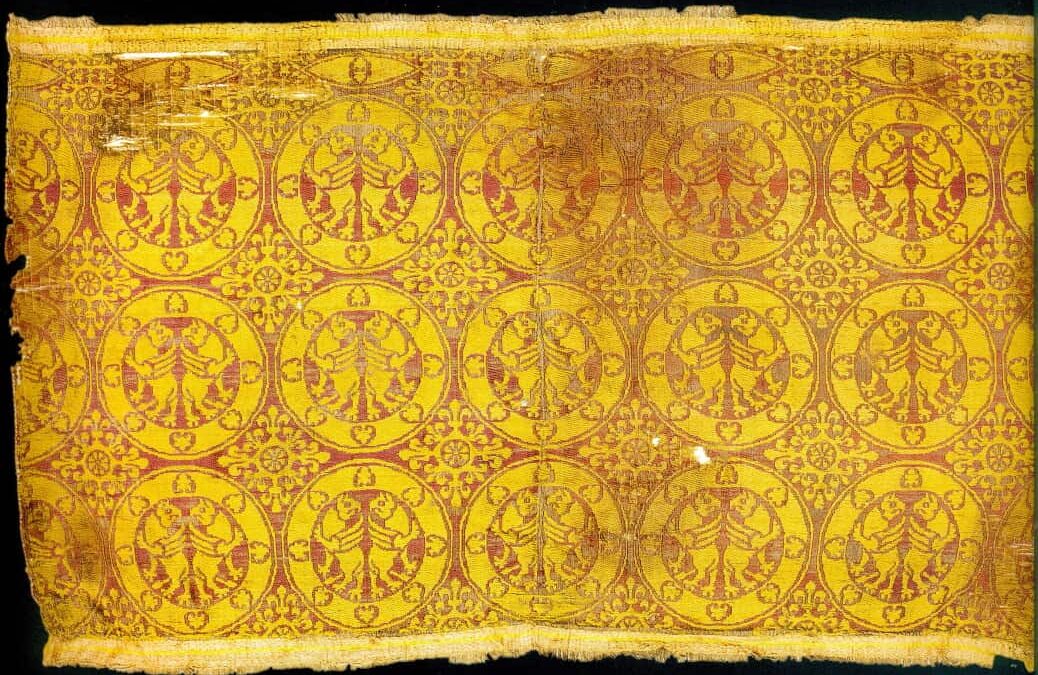Venice can boast a history of textile art which spans over a thousand years. But before the most famous velvets, it produced another equally precious silk fabric: samite.
Samites, the First Venetian Fabrics
In the 12th century, Venice ceased to merely import luxury fabrics from the East and started to produce them itself. The first ones were samites.
Samite is a fabric that from a technical point of view has a six thread array, in Greek hexamitos, from which it derives its name. It consists of two warps, a ground warp – building the pattern – and a binding warp, and with at least two wefts woven so as to follow diagonal lines.
It is a heavy fabric in pure silk, with a velvety hand and a satin-like and shiny finish. Just like many other fabrics, it originated in the Middle East, Iran and Syria, and spread throughout the Mediterranean area through Byzantium and the Arab domination.
Considered the most precious silk fabric of the Middle Ages, it could be admired on vestments and sumptuous clothes, which were a privilege of the upper classes of Venetian society. It often had rich decorations embroidered with gold and silver threads.
At that time, in Venice there was the corporation of the Samitieri, the skilled weavers of samites, which only later welcomed the Veluderi, the producers of velvets. In 1265 the Capitulare Samitariorum, the set of provisions that regulated its activity, was reformed. Among the others, there was a rule which forbade the use of any other yarns besides silk to produce this fabric, under penalty of its destruction. Only later, after the 12th century, different yarns were allowed, especially linen or hemp, which made the warp stronger. These fabrics, however, were defined as half silks (mezze sete in Italian).
Decorative Patterns of Samites
Samites often have decorative motifs “ad rotellas”, which are wheels or squares, with symbolic animals in the center. They began to appear from the 9th century A.D. and developed with modular ratios and diversified diameters, until the beginning of the 14th century.
The designs represent rosettes, griffins, lions, the tree of life and, parakeets. An example of this motif is found in our Leoni soprarizzo velvet. Greek words and Arabic inscriptions used for purely decorative purposes also often appear.
These patterns can also be found in the cloth that wrapped the casket of St. Anthony of Padua: it features palmettes inside the round frames with pairs of budgies in the center separated by the tree of life. They also appear in the vestments of Pope Boniface VIII, from the second half of the 12th century, with a great variety of animals and birds represented in the center of the roundels.
The Samite of St. Theodore
Samite is also somehow connected to the story of Venice’s patron saint. Before St. Mark, the city’s patron saint was St. Theodore of Amasea.
But in the 13th century, the saint’s mortal remains were transferred to Brindisi (a city in the south of Italy) wrapped in a precious samite, probably on the occasion of the wedding of Frederick II and Yolande of Jerusalem. It’s from that moment that the cult of St. Mark was born in Venice as the new patron saint of the city of which he became the symbol and to whom the splendid square and the majestic basilica were dedicated.

Saint Theodore’s samite – detail
Cover photo: Samite, Venice, 13th century





